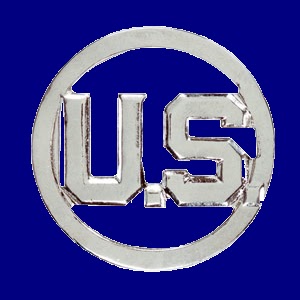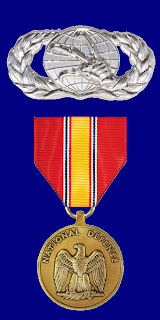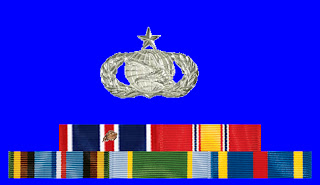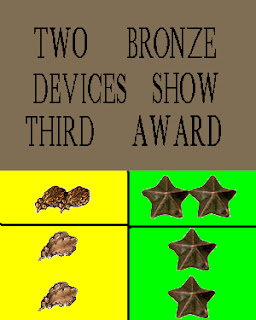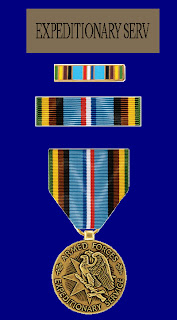This blog is dedicated to my children, grand-children, and all who may follow. As you may know, I have recently put together a summary of my Air Force Career in the form of a Medals Display Case. I also have a hat pin in the shape of the medal that I have affixed onto a baseball cap with the front being embroidered with US AIR FORCE VETERAN on the front. I served in the United States Air Force (USAF) from 1963-1971 during the height of the Viet Nam War ..... which as you know, was NOT a popular war with a lot of people in the U.S., due to the rebellion of the "Baby Boomers" against everything their parents stood for and the few instances of military abuse. However, all military personnel were then labeled as "Baby-Killers." It was not at all uncommon for soldiers, sailors, and airmen to be spit upon in public places especially on the west coast upon their return to the United States. It took a long time for me and ALL VIET NAM VETERANS to get healing. In my case it was a veterans day program put on by the Erie, Illinois Elementary school the first year I was the preacher at the Erie Baptist Church in 1997. Many Viet Nam Vets are still seeking healing. Now I can confess to anyone that I served proudly in the Air Force. The following pictures are put in the order from the beginning when I first joined the Air Force at the Induction Center in Indianapolis, Indiana through the Conclusion of my career at Pope Air Force Base, Fayetteville North Carolina. The command patches are usually shown as two. I was in what was known as Ground Radio Electronics Communication Maintenance Squadron which usually is known as a tenant organization. My commander was answerable to higher headquarters on another base. The first patch is the patch of the Command of the base. Then the medals and ribbons that I earned. The Commemorative medals and ribbons remind me of where I served and what I have done. The background color is naturally blue which was and is the color of the Class A Uniform. I will also give some information of each ribbon or medal when they first appear. Notice that the order of wear is not necessary according to when they were received. The order of the Commemoratives is according to where I found the information on them. The company is Medals of America and they are found at http://www.medalsofamerica.com/. So enjoy going down the memory path of a Cold War Veteran.
ENLISTED COLLAR BRASS
National Defense Service Medal
President Dwight Eisenhower created the National Defense Service Medal in 1953 to honor any service person who served honorably during a designated time period after a National Emergency had been declared by the United States government. These military ribbons and medals have been awarded to service persons who have performed active duty in a number of engagements between June of 1950 and July of 1954. The conflicts included are the Korean War, between January of 1961 and August of 1974; the Vietnam War, between August of 1990 and November of 1995; the Gulf War for its entire call-up and deployment period; and for all service rendered after September 11 of 2001 in the War on Terrorism, including all Iraq and Afghanistan service.
Military members who have received National Defense Service Medals and have served in more than one eligible campaign are authorized to wear Service Star devices to denote additional issues of these military awards. These military medals and ribbons are worn below the Navy Occupation Service Medal and the Army of Occupation Medal, and above the Korean Service Medal in the order of precedence which has been established for all military decorations. The National Defense Service Medal is generally available as Army, Air Force, Navy and Marine Corps, and Coast Guard decorations, and can be worn as traditional full size military medals, mini medals, military ribbons and lapel pins. Like most military medals, it is available as traditional slide-on, full size military medals, mini-medals, and slide-on military ribbons.
Air Force Small Arms Expert Marksmanship Ribbon
A Marksmanship Ribbon is awarded by the Air Force, the Army, Navy, Marine Corps, and the Coast Guard to service members who pass a weapons qualification course and achieve an above-average score. The Marksmanship Medal is the Air Force Medal equivalent of the Expert Marksmanship Badge in the Army and the Marine Corps. The Small Arms Expert Marksmanship Ribbon is the Air Forces’ only version of these US military medals. To earn these medals of America, personnel must qualify as an expert on either the M-16 rifle, the M-1 Carbine, or with the service persons’ job-designated handgun.
Qualification as expert with the rifle (M-16/M-4) for the Air Force Qualification Course (AFQC) is most common for Air Force members and requires 35 to 40 hits out of 40 rounds (if qualifying without a gas mask), or 43 to 50 hits out of 50 rounds on various sized silhouettes, simulating targets at different ranges. The target itself is 25 meters away, with silhouettes simulating targets at 50 meters, 100 meters, 150 meters, 200 meters, 250 meters and 300 meters. 10 shots are fired each from the standing-barricaded, kneeling-barricaded, prone-supported (with and without gas mask) and the prone-unsupported position.
The Air Force Small Arms Expert Marksmanship Ribbon is issued in only one degree; however, a bronze Service Star may be worn on the decoration for those in certain career fields like security forces and civil engineering who have qualified expert on both the service rifle and handgun. This award is worn below the Air Force Basic Training Honor Graduate Ribbon and above the Air Force Training Ribbon in the order of precedence for all Air Force medals and ribbons. These Air Force ribbons are available in traditional slide-on on ribbons and the newer, custom thin ribbons currently gaining widespread popularity for their sleeker appearance.
HOW RIBBONS WOULD BE WORN AT LACKLAND.
THEY ARE CENTERED ABOVE THE LEFT UPPER POCKET.
Air Force Training Ribbon
The Air Force Training Ribbon was established by the Air Force Chief of Staff in October of 1980. These US military medals are the lowest decoration awarded by the Air Force, and only rank above foreign military awards. These Air Force medals are authorized for completion of initial accession training after August of 1974. The Air Force defines initial accession training as Basic Military Training for enlisted personnel and either Doolie training which is available during the freshman summer at the US Air Force Academy, or through commissioning in an Air Force ROTC course, Officer Training School course, or other specialized US Air Force officer accession program. In December of 1986, the Air Force expanded these criteria to authorize this Air Force ribbon to anyone who was on active duty in December 1986, regardless of when they completed initial accession training. These medals of America awards may not be awarded for completing flight training, technical training, career development courses, professional military education (PME) and other services' basic training or officer training. Air Force enlisted personnel who initially accessed through BMT, and who later complete officer accession training will be entitled to a subsequent award denoted by an Oak Leaf Cluster.
The Army Training Ribbon is the equivalent of the Air Force Training Ribbon, but the Navy and the Coast Guard don’t have military awards corresponding to it. The Marine Corps has a similar award in their Eagle, Globe and Anchor insignia which is presented upon completion of Recruit Training or Officer Candidate School, or at the commissioning of Marine Corps officers from the Naval Academy or a Naval ROTC program. The Navy forbids the display of these military ribbons on Naval Service uniforms worn by former Air Force personnel.
The Air Force Training Ribbon is worn below the Air Force Marksman Ribbon and above the Philippine Defense medal in the general order of precedence that has been established for the display of all Air Force ribbons and medals.
AIR FORCE SPECIALITY BADGE.
NOW GIVEN AT GRADUATION FROM TECHNICAL SCHOOL.
THIS BADGE IS WORN ABOVE THE RIBBONS AND OR MEDALS.
2861 GEEIA SQUADRON
GEEIA stands for Ground Electronic Engineering Installation Agency. I would be sent on temporary duty to different bases to install Ground Radio Gear. I installed radio transmitters, radio receivers, radio direction finders for use by the Air Traffic Controllers at bases from Andrews AFB, MD to Loring AFB, ME and to Incerlick AB at Adana, Turkey. While I was stationed at Olmstead, I was out on TDY more time spent on the base.
Air Force Outstanding Unit Award
In 1954, the Air Force created The Air Force Outstanding Unit Award to honor any Air Force or Reserve Air National Guard command which performs exceptionally meritorious service, specific acts of outstanding achievement, excels in combat operations against an armed enemy, or during exposure to hostile actions by an opposing foreign force. These Air Force ribbons are considered a personal decoration and may be worn whether or not a unit member continues as a member of the awarded organization.
When the Air Force Outstanding Unit Award is bestowed for combat or combat support service, the “V” device for valor is authorized. The military ribbons and medals order of precedence require that these Air Force decorations fall just below the Meritorious Unit Commendation and just above the Air Force Organizational Excellence Award when being displayed has mounted military ribbons. These Air Force ribbons are considered equivalent to the Army Superior Unit Award, the Navy Unit Commendation, and the Coast Guard Unit Commendation. Multiple awards of the AFOUA are denoted by Oak Leaf Cluster devices. A Unit Banner is also authorized for display.
The Air Force Outstanding Unit Award is generally available as an Air Force ribbon, lapel pin and a unit banner. These military awards can be worn as traditional slide on ribbons and are also available as thin ribbons for extra sleek appearing mounted military ribbons displays.
This is the highest ribbon I would be awarded in my Air Force Career.
THE STAR SIGNIFIES THE ATTAINMENT OF THE TECHICIAN SKILL LEVEL. THIS WAS REQUIRED FOR THE NEXT PROMOTION ALONG WITH CERTAIN AMOUNT OF TIME IN GRADE AT THE RANK OF AIRMAN SECOND CLASS FOR PROMOTION
TO AIRMAN FIRST CLASS.
Armed Forces Expeditionary Medal
President John Kennedy created the Armed Forces Expeditionary Medal in 1961. These military awards are presented to military personnel for participation in any military campaign for which no other service medal has been authorized. These military medals and ribbons have been awarded in 45 campaigns since their inception in the 1961, with the Cuban Missile Crisis being the first. Following their original issuance, these military decorations were made retroactive to 1958.
In 2003 the Global War on Terrorism Expeditionary Medal replaced the Armed Forces Expeditionary Medal for Iraq, Saudi Arabia and Kuwait service theatres. After March of 2003 some personnel became eligible for both the Global War on Terrorism Expeditionary Medal and the Armed Forces Expeditionary Medal, although only one of these medals may be awarded to any individual for the same duty time. Since 1992, the Armed Forces Expeditionary Medal has been phased out in favor of campaign specific medals and the newer Armed Forces Service Medal. However, the Armed Forces Expeditionary Medal is still considered an active service medal. The Global War on Terrorism Expeditionary Medal is considered a very similar award, and was issued for service in Afghanistan and Iraq until it was replaced by the Iraq Campaign Medal and the Afghanistan Campaign Medal in June of 2005. The Armed Forces Expeditionary Medal is no longer issued for operations in the Middle East theaters.
The Navy and Marine Corps each issue a similar decoration. Service members in these branches may choose between the Navy Expeditionary Medal and Marine Corps Expeditionary Medal and the Armed Forces Expeditionary Medal, though they can’t receive both for the same duty. The Air Force also has the similar sounding Air Force Expeditionary Service Ribbon, but it is not related to the Armed Forces Expeditionary Medal.
Additional awards of the Armed Forces Expeditionary Medal are denoted by Service Stars. The Army also authorizes Arrowhead Devices for participation in airborne or amphibious assaults, and sailors may earn the Fleet Marine Force Combat Operation Insignia. These military ribbons and medals are worn below the Antarctica Service Medals and above the Vietnam Service Medals in the general order of precedence which has been established for all military ribbons and medals. The Armed Forces Expeditionary Medal is generally available as Army, Air Force, Navy and Marine Corps, and Coast Guard decorations, and can be worn as traditional full size military medals and mini medals, military ribbons and lapel pins. Like most military medals, it is available as traditional slide-on, full size military medals, mini-medals and slide-on military ribbons.
In 2003 the Global War on Terrorism Expeditionary Medal replaced the Armed Forces Expeditionary Medal for Iraq, Saudi Arabia and Kuwait service theatres. After March of 2003 some personnel became eligible for both the Global War on Terrorism Expeditionary Medal and the Armed Forces Expeditionary Medal, although only one of these medals may be awarded to any individual for the same duty time. Since 1992, the Armed Forces Expeditionary Medal has been phased out in favor of campaign specific medals and the newer Armed Forces Service Medal. However, the Armed Forces Expeditionary Medal is still considered an active service medal. The Global War on Terrorism Expeditionary Medal is considered a very similar award, and was issued for service in Afghanistan and Iraq until it was replaced by the Iraq Campaign Medal and the Afghanistan Campaign Medal in June of 2005. The Armed Forces Expeditionary Medal is no longer issued for operations in the Middle East theaters.
The Navy and Marine Corps each issue a similar decoration. Service members in these branches may choose between the Navy Expeditionary Medal and Marine Corps Expeditionary Medal and the Armed Forces Expeditionary Medal, though they can’t receive both for the same duty. The Air Force also has the similar sounding Air Force Expeditionary Service Ribbon, but it is not related to the Armed Forces Expeditionary Medal.
Additional awards of the Armed Forces Expeditionary Medal are denoted by Service Stars. The Army also authorizes Arrowhead Devices for participation in airborne or amphibious assaults, and sailors may earn the Fleet Marine Force Combat Operation Insignia. These military ribbons and medals are worn below the Antarctica Service Medals and above the Vietnam Service Medals in the general order of precedence which has been established for all military ribbons and medals. The Armed Forces Expeditionary Medal is generally available as Army, Air Force, Navy and Marine Corps, and Coast Guard decorations, and can be worn as traditional full size military medals and mini medals, military ribbons and lapel pins. Like most military medals, it is available as traditional slide-on, full size military medals, mini-medals and slide-on military ribbons.
Air Force Good Conduct Medal
The Air Force was the last of the five U. S. Military branches to establish a Good Conduct Medal. These Air Force ribbons and medals were authorized by Congress on July 6, 1960, but not created until June of 1963. Previously, between 1947 and 1963, the Air Force issued its personnel Army Good Conduct Medals, and airmen serving since before 1963 may wear both simultaneously. While the Air Force medals are the same as the Army version, the Air Force ribbons are different from the Army version. The Air Force has frequently seemed ambivalent toward the Good Conduct Medal. In addition to being the last to create one, they also discontinued it for three years between 2006 and 2009, apparently feeling that Air Force personnel were expected to behave well during their tours of duty, so why issue an Air Force decoration that honored what they considered normal behavior. However, since some Air Force personnel inevitably mess up, these military decorations were reestablished to reward those who did not.
The Air Force Good Conduct Medal is currently awarded to enlisted personnel during a three-year period of active military service or for a one-year period of service during a time of war. Airmen presented these military awards must have had character and efficiency ratings of excellent or higher throughout the qualifying period including time spent in attendance at service schools, and there must have been no convictions of court martial during this period.
The Air Force Good Conduct Medal is worn just below the Prisoner of War Medal and just above the Air Reserve Forces Meritorious Service Medal in the general order of precedence for all Air Force military medals. Additional awards of the Air Force Good Conduct Medal are denoted by Oak Leaf Clusters worn on the ribbons.The Air Force Good Conduct Medal is commonly available as Air Force medals, ribbons, and lapel pins among the more readily available forms.
This is the highest medal I received during my Air Force Career and the medal I am most proud of since an officer CANNOT be awarded this one.
Air Force Overseas Short Tour Service Ribbon
The Air Force Overseas Service Ribbon was created by the Air Force Chief of Staff in 1980. This military award was authorized in two grades designated Short Tour and Long Tour, respectively. These US military medals honoring the Short Tour are presented to Air Force personnel who serve tours of duty of less than two years in duration. Normally, these Air Force ribbons are awarded for a permanent duty assignment of at least 181 consecutive days or, if stationed overseas, 300 days within an 18-month time span; such assignments are generally served unaccompanied by family members, though a short tour assignment need not be unaccompanied. Historically, most Short Tour Service Ribbons were awarded for service in South Korea, by far the most common short tour assignment in the USAF. There are no corresponding military medals for this award.
Additional awards of the Air Force Overseas Service Ribbon are denoted by Oak Leaf Clusters. Air Force personnel are allowed to wear both of these medals of America simultaneously. The “A” device is authorized only on the short tour ribbon to any service member who performs a tour of duty at an arctic based Air Force facility. These military ribbons are worn below the Air and Space Campaign Medal and above the Air Force Overseas Long Tour ribbon in the general order of precedence that the Air Force has established for the display of all military medals and ribbons. They are generally available as Air Force ribbons and lapel pins, and were traditionally worn as slide on ribbons. Nowadays however, more and more military service personnel are realizing the value to their career goals of always having their uniform decorations looking their best, and have turned to the slimmer and trimmer ultra thin ribbon racks to provide them with the smartest looking military award displays possible.Vietnam Service Medal
In July of 1960 President Lyndon Johnson issued and Executive Order establishing the Vietnam Service Medal. These military decorations are issued to recognize service by any member of the US military during the Vietnam War. These military ribbons and medals were presented for 31 days or more of consecutive duty, or 60 days of non-consecutive duty with one or more organizations participating in direct support of ground operations, or for service aboard naval vessels in support of military operations in the Republic or Vietnam, Thailand, Cambodia or Laos, between the dates of November 1961 and March of 1973. These military medals were also issued for service on the two days at the end of April of 1975. The Air Force awards these military medals for personnel who flew missions over Vietnam air space.
The Defense Department divides the Vietnam War into 30 military campaigns, and awards Service Stars to one or more service branches for participation in each of them. The Arrowhead Device is authorized for certain amphibious assaults, as is the Fleet Marine Force Combat Operation Insignia. The Vietnam Service Medal is worn below the Armed Forces Expeditionary Medal, and above the Southwest Asia Service Medal in the general order of precedence that has been established governing the placement of all Military ribbons and medals in uniform award displays. The Vietnam Service Medal is generally available as Army, Air Force, Navy and Marine Corps, and Coast Guard Awards, and can be worn as traditional full size military medals, mini medals, military ribbons and lapel pins. Like most military medals, it is available as traditional slide-on, full size military medals, mini-medals, and slide-on military ribbons.
Air Force Longevity Service Ribbon
Air Force General Thomas White ordered the creation of the Air Force Longevity Service Ribbon when he was Chief of Staff in 1957. These US military medals were the Air Force equivalent to Service Stripes used in the other branches of the military to denote years of service. These medals of America are awarded to Air Force personnel serving in either the Active Reserve, or the Air National Guard for four years of drilling status service including regular attendance for weekend drills and annual training camps. These military ribbons are awarded to both officers and enlisted personnel, in contrast to service stripes which are only provided to enlisted members of the military. The Air Force does not offer corresponding military medals for this award.
The Air Force Longevity Service Ribbon is worn below the Air Force Expeditionary Service Ribbon and above the Military Training Instruction Ribbon in the general order of precedence established for the display of all Air Force medals and ribbons. The award is retroactive to the founding of the Air Force in 1947, and additional awards of the Air Force Longevity Service Award are denoted by Oak Leaf Clusters. These Air Force awards are available as military ribbons and lapel pins, and are traditionally worn as slide-on military ribbons. THESE ARE ALL THE AIR FORCE RIBBONS I WAS AWARDED.
THESE ARE ALL THE AIR FORCE MEDALS I WAS AWARDED.
WELL IT IS TIME FOR ANOTHER OVERSEAS ASSIGNMENT. IT LOOKS LIKE I WILL BE STATIONED NEAR PISA ITALY AND CAN TAKE WANDA AND RUTH. WANDA HAD HER PASSPORT PICTURE TAKEN WITH RUTH BUT THAT AFTERNOON THE ASSIGNMENT WAS CHANGED TO MT. ETNA ON SICILY AND NO DEPENDANTS AND 12 MONTHS LONG. GUESS WHAT. ORDERS CHANGED AGAIN TO MT. LIMBARA SARDINIA. THIS WAS FOR FIFTEEN MONTHS AND ONLY 40 MEN ASSIGNED NO DEPENDANTS AND THE NEAREST U. S. MEDICAL FACILITY WAS THE NAVY AT NAPLES ITALY. SO WANDA AND RUTH STAYED AT ROME NEW YORK. [THE REAL IRONY WAS THAT DURING MY LEAVE THE WHOLE ASSIGNMENT WAS CANCELLED.]
THIS IS WHAT MY LEFT SHOULDER WOULD LOOK LIKE IF I COULD WEAR ALL THE MEDALS (AIR FORCE AND COMMEMORATIVE) AT THE SAME TIME.
THIS IS WHAT MY VETERANS CAP LOOKS LIKE WITH ALL THE HAT PINS ON IT.
Air Force Outstanding Unit Award Commemorative Medal
American Defense Service Commemorative Medal
Vietnam Defense Commemorative Medal
Instituted: 1995
Qualifying Dates: 1961 - 1975
Criteria: Stuck to honor all military personnel who served in South Vietnam or in direct support from Thailand, Guam, Okinawa, Philippine Islands or the waters off shore between 1962 and 1975.
Cold War Victory Commemorative Medal
Qualifying Dates: 1945 - 1991
Criteria: Struck to recognize any honorable military service between 2 Sept 1945 and 26 December 1991.Foreign Expeditionary Service Commemorative Medal
Instituted: 2004
Qualifying Dates: All Periods
Criteria: To honor all US military personnel who served in a foreign expeditionary operation.
Overseas Service Commemorative
Instituted: Qualifying Dates:
Criteria: Struck to honor all Soldiers, Sailors, Marines and Airmen who served in an overseas theater or expeditionary operation outside the United States for 30 days or more.
NATO Service Commemorative Medal
Criteria: Honors all US Armed Forces who served in Europe anytime from 1948 to present.
Air Force Service Commemorative Medal
Instituted: 1999
Qualifying Dates: 1947 - Present
Criteria: Struck to honor all who honorably served in the U.S. Air Force between 1947and the present.
Criteria: Struck to honor all who honorably served in the U.S. Air Force between 1947and the present.
Honorable Service Commemorative Medal
Qualifying Dates: All Periods
Criteria: To honor those who received an honorable discharge from any US military service.
Armed Forces Expert Marksman Commemorative Medal
Criteria: Honors all US Armed Forces who have qualified as an expert marksman with any weapon
WELL KIDS, THAT IS "MY STORY" OF HOW I SPENT THOSE EIGHT YEARS IN THE USAF. I KNOW I HAVE LEFT STORIES OUT... LIKE WHEN I WAS TDY AT LORING AFB IN MAINE. WE (THE GEEIA TEAM) HAD TO TRAVEL BY OFFICIAL MILITARY TRUCK DOWN THE PARKING AREA OF THE B52'S. AT THE TAIL OF THOSE B52'S THERE WERE FOUR 20 MM GATLING GUNS AS A FINAL DEFENSE AGAINST ANY ENEMY FIGHTERS. WELL, ONE MORNING AS WE TRAVELED ALONG, ONE OF THE TURRETS BEGAN TRACKING US. WE WERE A MOVING TARGET FOR THE GUNNER TO CHECK HIS TRACKING RADAR!
ANYWAY, HOPEFULLY, THIS WILL GIVE YOU KIDS A GENERAL IDEA OF THE "WHERE, WHAT, AND WHEN" OF MY TIME IN THE AIR FORCE.
WITH LOVE,
YOUR DAD,
AKA "GRANDPA"
Mitchell N. Lindquist SSgt USAF Veteran
Criteria: To honor those who served at least 30 days in the United States during any period of service.
Criteria: Honors all airmen awarded the USAF Outstanding Unit Award Ribbon.




